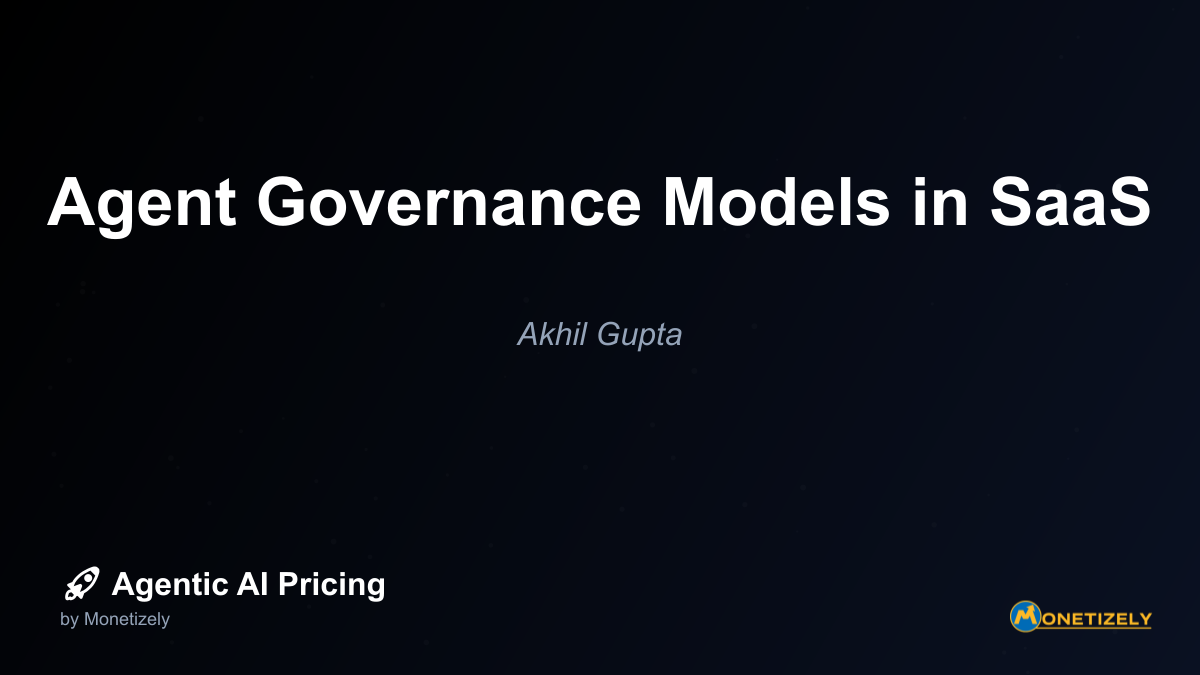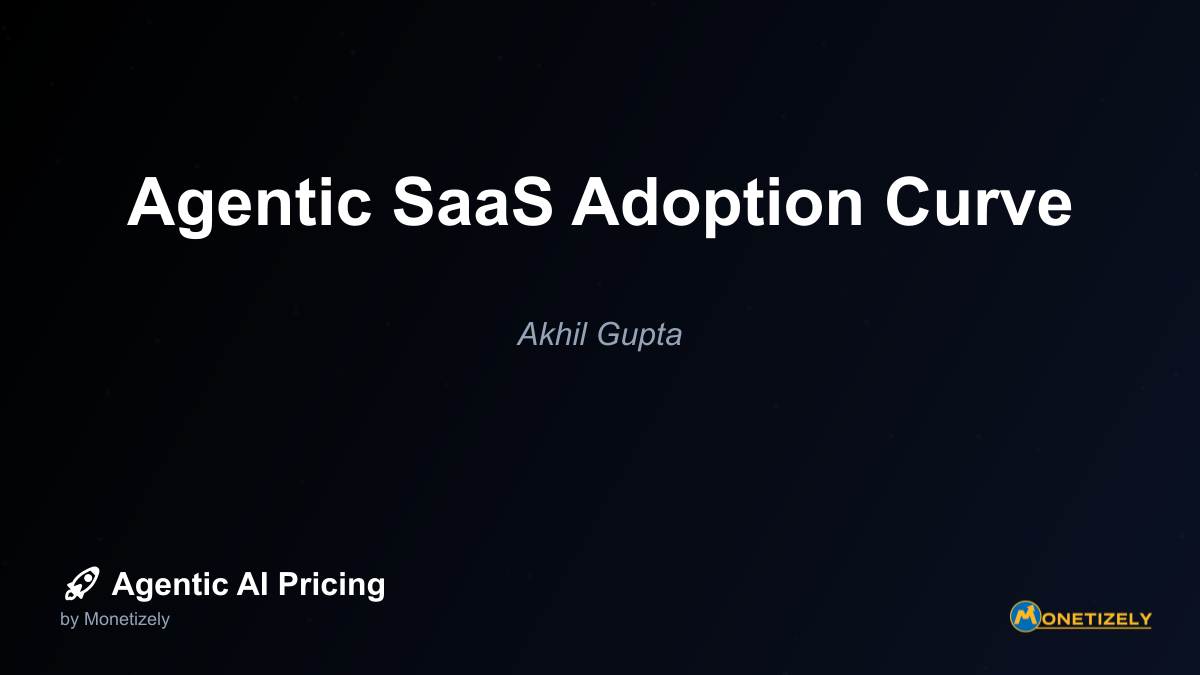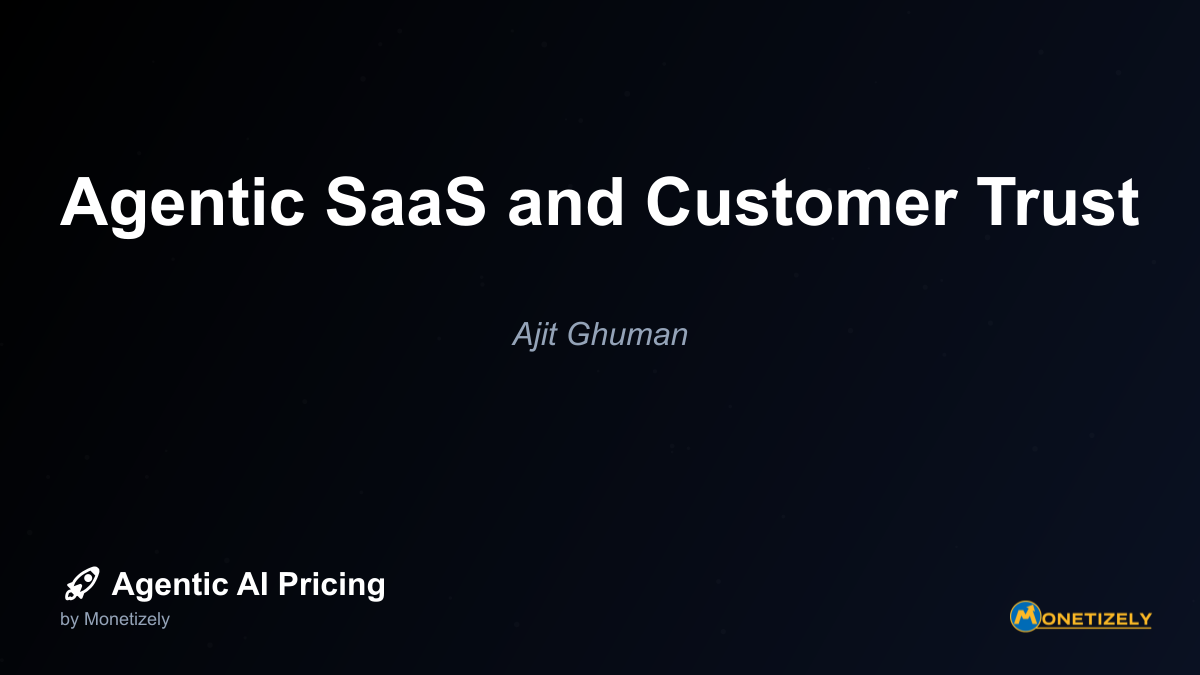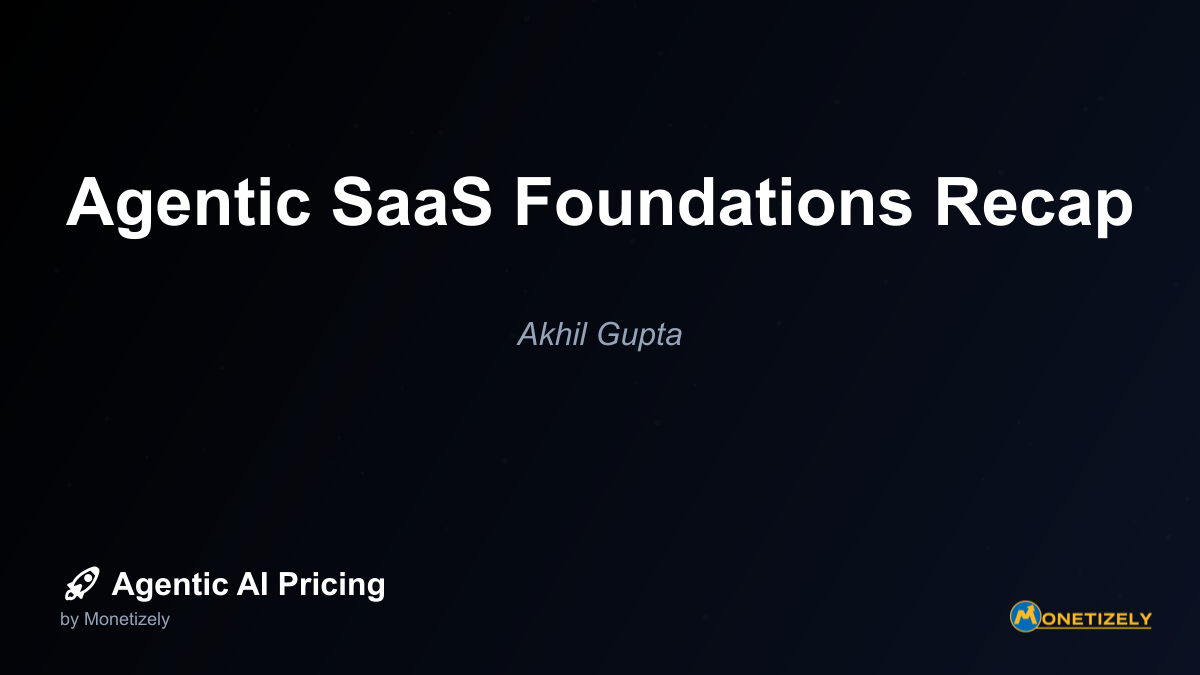· Akhil Gupta · Agentic SaaS Fundamentals · 5 min read
The Executive’s Guide to Agentic SaaS
AI and SaaS Pricing Masterclass
Learn the art of strategic pricing directly from industry experts. Our comprehensive course provides frameworks and methodologies for optimizing your pricing strategy in the evolving AI landscape. Earn a professional certification that can be imported directly to your LinkedIn profile.
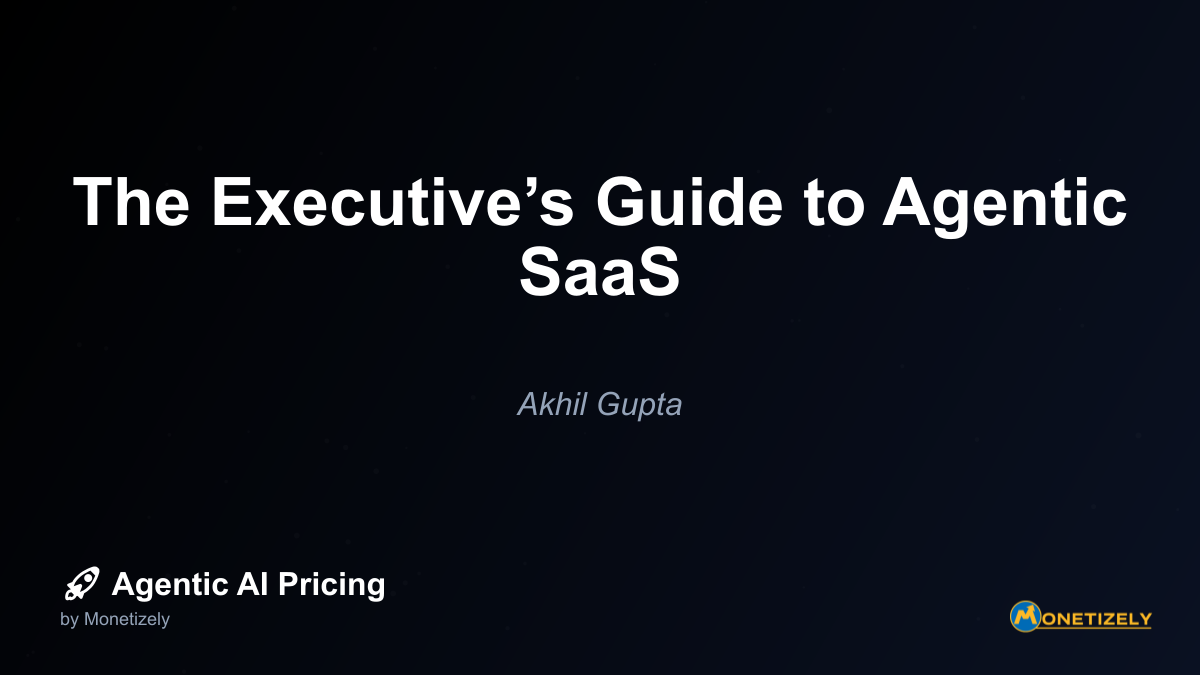
Understanding the pricing dynamics of agentic SaaS is crucial for executives making investment decisions. These systems introduce new pricing paradigms that differ significantly from traditional software models.
Emerging Pricing Models
Agentic SaaS pricing typically follows one of several models, each with distinct implications:
Value-Based Pricing
Unlike traditional SaaS where pricing often reflects development costs or competitor benchmarks, agentic systems are increasingly priced based on the tangible value they generate. This approach aligns vendor and client interests but requires sophisticated value measurement mechanisms.
Outcome-Based Models
Some vendors are pioneering fully outcome-contingent pricing, where fees directly correlate with measurable business results. For example, outcome-based pricing frameworks link payment to specific achievements like revenue increases, cost reductions, or efficiency gains.
Hybrid Approaches
Many implementations use tiered models combining:
- Base subscription fees for platform access
- Usage-based components for computational resources
- Performance incentives tied to business outcomes
ROI Calculation Framework
Evaluating agentic SaaS investments requires a more sophisticated ROI framework than traditional software:
Direct Value Metrics
- Labor cost displacement from automated processes
- Throughput increases from 24/7 operation
- Error reduction and quality improvements
- Decision speed improvements
Indirect Value Creation
- Competitive advantage from enhanced capabilities
- New revenue streams enabled by AI capabilities
- Risk reduction through improved compliance and monitoring
- Knowledge capture and organizational learning
Implementation and Operational Costs
- Initial integration and customization expenses
- Ongoing monitoring and governance requirements
- Training and change management investments
- Data infrastructure enhancements
Time-to-Value Acceleration
The most significant ROI advantage of agentic systems often comes from dramatically compressed time-to-value compared to traditional transformation initiatives. While conventional process improvements might take years to fully implement, agentic systems can begin delivering value within weeks or months.
Building Your Organizational Capability Model
Successfully leveraging agentic SaaS requires developing new organizational capabilities beyond traditional IT competencies:
Strategic Capability Requirements
AI Governance Expertise
Establish dedicated governance functions responsible for:
- Setting operational boundaries for autonomous systems
- Monitoring performance and ensuring alignment with objectives
- Managing ethical considerations and compliance requirements
- Developing intervention protocols for unexpected situations
Human-AI Collaboration Skills
Develop team capabilities for effective collaboration:
- Understanding AI system strengths and limitations
- Providing effective guidance and feedback
- Interpreting system outputs and recommendations
- Identifying opportunities for capability enhancement
Data Strategy and Management
Strengthen organizational data practices:
- Ensuring data quality and accessibility
- Managing privacy and security considerations
- Establishing feedback mechanisms for continuous improvement
- Creating appropriate training datasets for system development
Talent and Organizational Structure
Emerging Roles
Consider establishing specialized positions:
- AI Operations Specialists who monitor and manage agentic systems
- Prompt Engineers who design effective instructions for AI systems
- AI Ethics Officers who ensure responsible implementation
- Human-AI Collaboration Coaches who help teams work effectively with systems
Structural Considerations
Evaluate potential organizational models:
- Centralized AI Centers of Excellence that provide enterprise-wide expertise
- Embedded AI specialists within functional teams
- Hybrid models that combine centralized governance with distributed implementation
- AI advisory boards with cross-functional representation
Risk Management and Ethical Considerations
Agentic systems introduce novel risks that require executive attention:
Primary Risk Categories
Operational Risks
- System actions that produce unintended consequences
- Overreliance on autonomous systems creating single points of failure
- Integration challenges with legacy systems and processes
- Data quality issues affecting system performance
Strategic Risks
- Competitive responses to new capabilities
- Organizational resistance to new working models
- Skill gaps that limit effective implementation
- Dependency on specific vendors or technologies
Ethical and Compliance Risks
- Privacy concerns related to data usage
- Transparency challenges in explaining system decisions
- Potential bias in system operations
- Regulatory uncertainties in rapidly evolving landscapes
Mitigation Approaches
Develop comprehensive risk management strategies:
Governance Frameworks
Establish clear guidelines for:
- System boundaries and operational limitations
- Regular auditing and performance evaluation
- Human oversight requirements for critical decisions
- Incident response procedures
Technical Safeguards
Implement protective measures:
- Continuous monitoring systems for anomaly detection
- Progressive permission models for autonomous actions
- Simulation environments for testing before deployment
- Rollback capabilities for rapid intervention
Organizational Preparedness
Build resilience through:
- Cross-functional response teams for unexpected situations
- Regular scenario planning for potential challenges
- Continuous education on evolving capabilities and risks
- Clear accountability for system outcomes
Implementation Roadmap for Executives
Successful agentic SaaS implementation requires a structured approach:
Phase 1: Strategic Assessment (1-3 Months)
- Identify high-potential use cases with clear success metrics
- Assess organizational readiness and capability gaps
- Develop governance frameworks and ethical guidelines
- Establish executive sponsorship and cross-functional leadership
Phase 2: Pilot Implementation (3-6 Months)
- Select limited-scope applications with manageable risk profiles
- Implement in controlled environments with extensive monitoring
- Develop measurement frameworks for performance evaluation
- Build initial competencies in key teams
Phase 3: Scaled Deployment (6-18 Months)
- Expand successful applications to broader operational areas
- Develop internal centers of excellence for knowledge sharing
- Refine governance models based on initial experiences
- Integrate with strategic planning and budgeting processes
Phase 4: Organizational Transformation (18+ Months)
- Redesign processes to fully leverage agentic capabilities
- Develop advanced human-AI collaboration models
- Integrate agentic systems into core business operations
- Explore new business models enabled by advanced capabilities
Building Your Executive Action Plan
As you consider agentic SaaS adoption, focus on these immediate priorities:
1. Educational Foundation
Begin by developing a solid understanding of:
- Core capabilities and limitations of current technologies
- Industry-specific applications and use cases
- Implementation requirements and success factors
- Emerging ethical and regulatory considerations
2. Opportunity Assessment
Conduct a systematic evaluation of:
- High-value processes suitable for agentic augmentation
- Data readiness for potential applications
- Organizational capabilities and gaps
- Potential implementation partners and vendors
3. Governance Development
Establish foundational governance elements:
- Executive oversight committee with clear responsibilities
- Risk assessment framework for potential applications
- Ethical guidelines aligned with organizational values
- Performance measurement standards for evaluation
4. Strategic Roadmap
Create a phased implementation plan:
- Quick-win opportunities for initial validation
- Capability development priorities for key teams
- Technology and infrastructure requirements
- Long-term vision for organizational transformation
Conclusion: Leading the Agentic Transformation
The emergence of agentic SaaS represents a pivotal moment for organizational leadership. These systems offer unprecedented opportunities to enhance decision-making, accelerate operations, and create competitive advantage. However, they also introduce novel challenges that require thoughtful governance and strategic oversight.
Successful executives will approach this transformation with balanced perspective—embracing the potential while establishing appropriate safeguards. The organizations that thrive will be those that develop not just technical implementation skills but the deeper organizational capabilities required for effective human-AI collaboration.
As you navigate this journey, focus on building the foundational elements that enable responsible adoption: clear governance frameworks, appropriate risk management approaches, and strategic capability development. With these elements in place, agentic SaaS can become a powerful catalyst for organizational transformation and sustainable competitive advantage.
The most successful implementations will be those that view agentic systems not as replacements for human judgment but as partners that enhance human capabilities—combining the creativity, ethical reasoning, and contextual understanding of people with the analytical power, tireless operation, and pattern recognition of artificial intelligence.
Co-Founder & COO
Akhil is an Engineering leader with over 16+ years of experience in building, managing and scaling web-scale, high throughput enterprise applications and teams. He has worked with and led technology teams at FabAlley, BuildSupply and Healthians. He is a graduate from Delhi College of Engineering and UC Berkeley certified CTO.
Pricing Strategy Audit
Let our experts analyze your current pricing strategy and identify opportunities for improvement. Our data-driven assessment will help you unlock untapped revenue potential and optimize your AI pricing approach.

